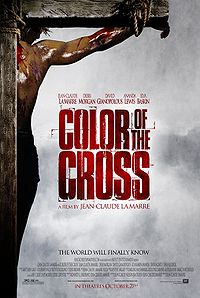
COLOR OF THE CROSS 2: THE RESURRECTION
US, 2008, 72 minutes, Colour.
Jean -Claude La Marre, Raquel Herring, Gerald Webb, Alysha Mallory.
Directed by Jean- Claude La Marre.
The reactions to Color of the Cross were mixed. Some alarming condemnations of making Jesus black can be found on the Internet Movie Database. They come from bloggers. These commentators do not seem to be aware of the tradition of adapting the figure of Jesus to the culture of those re-telling the story. In the 20th century, especially as a reaction against the white representations of Jesus and Mary, an abundance of Jesus images and Madonnas could be found, aboriginal Madonnas, Japanese Madonnas with local features and garb – holding the baby Jesus similarly dressed.
There were also vehement comments about the liberties taken in the screenplay in diverging from the Gospel texts. The comments on moving away from Gospel detail were just as strong Color of the Cross 2: The Resurrection.
The Resurrection opens with the agony in the garden and Jesus severely criticising Peter's inability to pray with him. During the credits there is a note that Yeshua is a radical intepreter of the Torah. In the background are voices recapitulating events of Yeshua's life. As the film goes on, especially in the crucifixion sequence, shown at quite some length, Jesus is tied by rope to the cross, not nailed. He is alone (although reference is made to the two other men crucified). There is no one at the foot of the cross. His mother, Mary, returns home to find Joseph and her two sons, James and Jude, arguing whether Jesus was really the Messiah or had deluded himself, referring to 132 texts from the Torah that he had to fulfil. Mary challenges them by reminding them that Yeshua had given to them land that was his by right. Later, on the road to Emmaus, the disciples encounter a wise man who opens their eyes to the resurrection.
Jean -Claude La Marre's Jesus is black but there is less emphasis in the screenplay on race as a political issue. On the cross, he is bearded. Risen, his head is shaven and he is beardless.
The running time of the film is comparatively short but there is quite some repetition from the first film. Jesus rises forty minutes into the film.
However, the writers, including La Marre, have drawn on many texts have a variety of characters (Apostles, priests and pharisees) quote and explain them. Mary Magdalene offers a voiceover commentary as well as a flashback to Jesus' kind treatment of her. Pilate features with the priests and the tomb guards and remarks to his wife who says sheknew him that he wished he had washed his hands of the whole affair.
Judas features quite strongly asdoes his killing himself and rather condemnatory apostles coming across his haning body.
The resurrection is suggested by some had movement under the burial cloths, then an earthquakeand sight of the stone rolled away. Many of the Gospel resurrection texts are used: the burial of Jesus by Nicodemus and Joseph of Arimathaea; the fear of the soldiers, Magdalene's enounter with the angel at the tomb and with Jesus, much discussion among the Apostles about what they should do, their fears and Thomas's disbelief. There are warm scenes where Yeshua's mother and the Magdalene converse.
Production values and re-constructions are limited but often effective. During the final credits, the director takes the opportunity to go through key scenes yet again.
1.In the tradition of Gospel films? Comparisons?
2.The intentions of the film, to recreate the Gospel scenes, to highlight the suffering and death of Jesus, the resurrection?
3.The racial themes? Jesus and the disciples as black? Mary and Joseph? The characters who were white in the film, who were black?
4.The changing of the Gospel texts, Mary and her sons, the relationship with Joseph? The road to Emmaus and a different person explaining the resurrection? The aftermath of the resurrection, the disciples in Galilee, their issues amongst themselves?
5.The portrait of Jesus, Yeshua, the film opening with the agony in the garden, the close-up of Jesus, the encounter with Judas, his confrontation with Peter? The insertion of the sequences of the Passion, the trial? The long take of the crucifixion? The flashbacks to Jesus and his ministry, to the last supper and the Eucharist? To the encounter with Mary Magdalene? His relationship with his mother?
6.The build-up to the resurrection, Mary Magdalene, the disciples, the stone rolled away, the empty tomb, Mary’s encounter with Jesus? Jesus and the moving of the cloths, his appearing to people?
7.The range of characters, Pilate and his wanting to wash his hands, his wife and her intercession for Jesus? Cleopas and the disciple on the road to Emmaus and their return? The various apostles, their discussions amongst themselves, fears, scepticism, their reaction to the appearances of Jesus?
8.Mary Magdalene, her background, the emphasis on her character? With the apostles after Jesus’ death, the resurrection experience, her being an apostle of the resurrection?
9.Nicodemus, Joseph of Arimathea, the plea before Pilate, the burying of Jesus?
10.Mary Jesus’ mother, her family, the squabbles between James and Jude, the praise of Jesus for his kindness to his brothers? Joseph and his concern?
11.A variety of Gospel texts, Gospel interpretations? The African American Jesus?